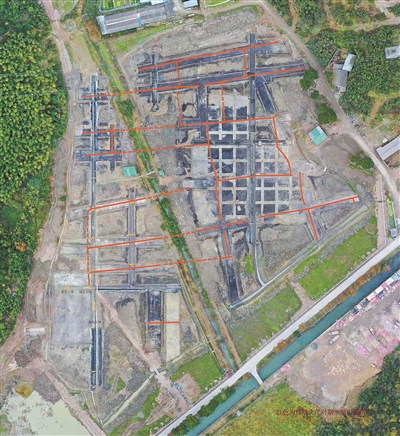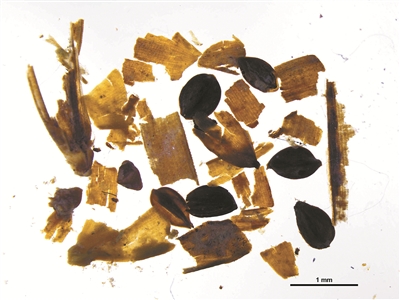Chinese archaeologists have discovered the world's oldest rice paddies dating back to around 6,300 years.
The large expanse of prehistoric rice paddies was found in the city of Yuyao, east China's Zhejiang Province.
Unearthed in the Shi'ao Ruins, about 7.5 kilometers away from the renowned Hemudu Site, the paddies provide insight into the prehistoric society along the lower reaches of the Yangtze River.
The new discovery was announced over the weekend by the Zhejiang Provincial Institute of Cultural Relics and Archaeology and the Ningbo Cultural Heritage Management Research Institute.
The ancient fields cover an area of about 900,000 square meters, according to preliminary research, but so far 7,000 square meters of land have been excavated.

An aerial photo shows the pattern and road system of the ancient paddy fields in the southern part of the Shi'ao site in Yuyao, east China's Zhejiang Province. /Ningbo Daily
An aerial photo shows the pattern and road system of the ancient paddy fields in the southern part of the Shi'ao site in Yuyao, east China's Zhejiang Province. /Ningbo Daily
"Archaeologists had found some smaller ancient paddy fields here in the past, with insufficient evidence," said Wang Yonglei, a researcher with the Zhejiang Provincial Institute of Cultural Relics and Archaeology, who was in charge of the on-site archaeological excavation at the Shi'ao Site.
"[The rice paddies found at] the Shi'ao Site in Yuyao, Zhejiang are large with organized patterns. They can be traced back to the early Hemudu Culture. This is the largest and oldest large-scale ancient paddy field in the world," Wang said.
Archaeologists said that the paddies had different forms across three prehistoric periods, spanning about 2,000 years. The oldest ones, featuring mounds of soil around their edges, date back to around 4,300 BC during the early stage of the Neolithic Hemudu Culture.
Between 3,700-3,300 BC during the late stage of the Hemudu Culture, researchers found fields with structurally clearer ridges, comprising of raised strips used as roads or demarcations.

Rice glumes, cobs and weed seeds selected from paddy soil dating back to the Liangzhu Culture period. /Courtesy of the Zhejiang Provincial Institute of Cultural Relics and Archaeology
Rice glumes, cobs and weed seeds selected from paddy soil dating back to the Liangzhu Culture period. /Courtesy of the Zhejiang Provincial Institute of Cultural Relics and Archaeology
Archaeologists also found newer paddies in a checkerboard type, with some complete with roads and irrigation systems, which go back to 2,900-2,500 BC in the era of Liangzhu Culture.
The discovery of the paddy sites suggested that rice farming was already an economic pillar in early Chinese cultures like Hemudu and Liangzhu.
"We discovered five prehistoric human village sites in an area of one square kilometer around the rice fields," Wang added, noting that villagers nearby were likely to be those who farmed the fields.
Researchers said they will continue their work on the historical roots of rice farming and look for settlements that match the ancient rice fields of Shi'ao Site.

